Stir-fry Chinese vegetables are so easy to prepare that we often take it for granted. Chinese vegetable stir fry may not qualify a place on the banquet menu, but it remains as the most popular dish among Chinese households. Its popularity is because it can be completed within five minutes, with only a handful of ingredients.
I will take the minimalist route in this recipe, focusing on how to bring out the flavor of the vegetables and the garlic with the right technique.
In summary, here are the techniques:
- Do not blanch the vegetables to soften it before stir-frying. Stir-frying all the way to retain the gravy (that is flavor!).
- Peel off the tough, fibrous surface of the large stalks.
- Season the garlic with plenty of salt. (It works!)
If you do it correctly, it can be one of the most delightful vegetarian dishes that you can dream of. Not all the recipes required a myriad of spices and herbs!
Now let’s dive into the details.
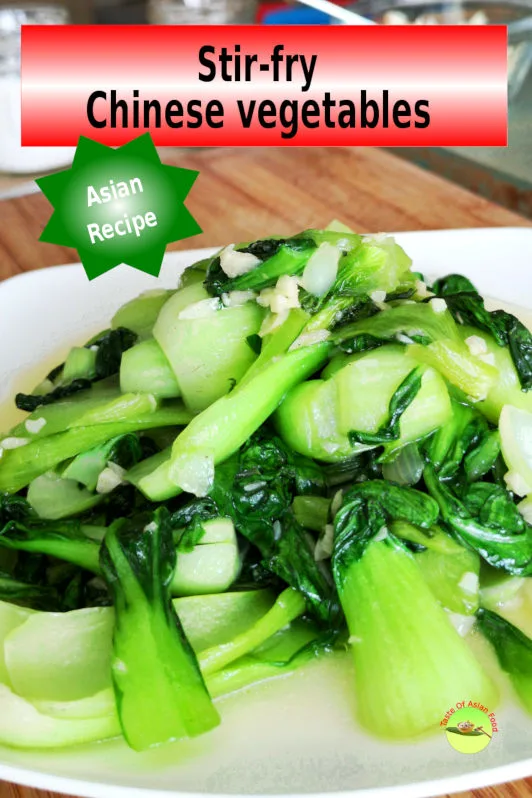
Note: This post may contain affiliate links. Please read my privacy policy for more info. I may receive commissions for purchases made through links in this post. As an Amazon Associate, I earn from qualifying purchases.
Common Chinese vegetable for stir-frying
The following are some of the most common Chinese vegetables that we cook at home:
Gai lan (also known as Chinese kale /Chinese broccoli/芥兰) is a variant of broccoli with longer stalk. It has large flat leaves instead of florets. It has a slightly bitter taste, so it’s good to add a little more sugar during stir-frying. The young gai lan is very tender, but the stalk large gai lan has a tough fibrous surface. You need to peel off the surface of the stalk and cut it into slices before stir-frying.
Choy sum (菜心)has also large, flat leaves but with slender stalk. It has a milder flavor and is not bitter at all. Since the stalk is tougher, it is best to separate the stalk from the leaves. Simmer the stalk with minimum water for a few minutes until tender, then add the leaves to continue stir-frying. There are also young choy sum available, which are very tender, which can proceed to stir-frying straight away.
Bok choy (白菜) has distinctive white, fat stems and dark green leaves. It has a sweeter flavor compared to gai lan and choy sum. Since the stalk is tougher, it is best to cook the stalk separately first as for the large choy sum.
How to stir-fry Chinese vegetables with garlic
Here is the general technique on how to stir-fry leafy Chinese greens. You can use this method to cook any leafy vegetables with a delightful result.
The steps below may not apply to all the vegetables that I cook, which I will mention with the explanation.
1. Peel off the fibrous surface of the stalk (for the larger vegetables)
Cut off the stem of the vegetables.
For the large and older vegetables, remove the fibrous surface of the stalk with a vegetable peeler until the white part of the stalk is revealed. You can relate it to preparations for asparagus.
Smaller and young gai lan, choy sum, and bok choy are more tender, which can be used to stir-fry straight away.
2. Rinse the Chinese vegetables thoroughly
Rinse the vegetables by changing the water at least twice. You can also do this under running water. The goal is to remove any sand or dirt that adheres to the vegetables. It is also useful to soak it with water for fifteen minutes or longer to remove any possible pesticides that may be used while growing the vegetables.
3. Separate the stems and leaves (for the larger vegetables)
Once you have cleaned the vegetables, separate the leaves and the stalks. Stir fry the stalks first until they start to turn tender before adding the leaves.
I do not blanch the vegetables to make them tender before stir-frying. Although blanching helps to tenderize them and cut short the time required for stir-frying, it also destroys the nutrients and loses flavor into the water. As a result, the vegetable will not be as tasty as you wish.
If you stir-fry the vegetables longer to make it softer, the gravy will remain in the wok, which will eventually be reabsorbed back to the vegetables, and make it very tasty. I made the same mistake before until I decided to stir-fry the vegetables without blanching it, and I can immediately taste the difference.
However, stir-frying root vegetables and broccoli is an exception. It will take forever to wait until the vegetables turn soft if you do not blanch it in advance. This blanching method is popular among Chinese restaurants as it is the quickest way to prep for a large order. You can ditch the blanching method by steaming it at home, which will retain most of the nutrients and flavor, although it is not practical to carry out in the restaurant.
4. Wash and drain the vegetables with a colander
Wash the greens thoroughly with water and drain by putting them in a colander (or with a salad spinner). The vegetables should contain very little water for the best stir-frying result. Otherwise, the vegetables will be steamed or braised, and lose their crisp texture. The result is stir-frying without the signature wok aroma (wok-hei).
5. Cut the garlic into small pieces
Stir-fry Chinese vegetable with garlic is the basic recipe in most ordinary households. The flavor is incredible with any sort of vegetables. My favorite method is to smash the garlic with the flat side of the cleaver, then coarsely chopped it. I prefer larger pieces of garlic due to two reasons:-
- The small pieces of garlic will cling on to the vegetables, and deliver extra flavor for each bite. The garlicky flavor is less if you leave it as the whole clove.
- Minced garlic is not my favorite as it can get burned quickly during stir-frying.
6. Saute the garlic over low heat
The Chinese vegetable stir fry sequence starts with adding some cooking oil into the wok over low heat. Swirl the oil around so that the oil is fully coated at the bottom of the wok.
The oil should not be too hot as it will burn the garlic quickly. If the oil starts to smoke, switch off the stove for a while before adding the garlic.
Add the coarsely chopped garlic to the oil and saute until it is just about turning to light brown.
By this time, the oil has infused with the garlic flavor, which will coat the vegetables that are added subsequently. Keep in mind that the garlic will be stir-fried together with the vegetables, and that is why it should be just about turning to light brown.
7. Add salt to the garlic
Adding salt to the garlic instead of the vegetables is another trick that I have discovered. My method is to add ALL the salt necessary for the whole dish to the garlic. The garlic pieces will become salty, which will cling on to the vegetables while serving, and gives a nice contrast to the more subtle flavor of the vegetables. It tickles your taste buds more, which is similar to why pickles are included inside the burger.
Part of the salt will dissolve in the oil, which will in turn flavor the vegetables.
8. Cook the stalk first, then the leaves (for the large vegetables)
Don’t crowd the wok. Choose a wok or a frying pan large enough to hold more vegetables than you think. This Chinese vegetable stir fry needs ample space to allow you to flip and stir the vegetables without falling off the edge. The vegetables take up lots of space initially and eventually will wilt down to only one third or even one-fourth of the original volume.
Start by adding the stalks to the wok and stir-fry for one to two minutes until the stalks start to turn soft. Add some sugar and pepper to season it at any time you like.
Next, add the leaves to the wok and continue stir-frying, which takes a much shorter time to cook than the stalk.
Do I need to simmer the vegetables?
It depends on the size of the vegetables.
Some bok choy and choy sum come with bigger stalks, which take a much longer time to soften. You can add a few tablespoons of water to simmer until it turns soft. The time required depends on the intensity of heat and also how hard the vegetables are, but it is usually within half to 2 minutes. I do that for the choy sum most of the time, which you can see how it is done in the video embedded in this article. Check the doneness regularly, because the vegetables will no longer crisp if you overdo it.
It is not necessary to simmer the vegetables if they are young and tender. The vegetables release water during stir-frying while wilting down, which will be cooked by its gravy.
However, add a tablespoon or two of water if it is too dry. The goal is to keep the temperature high at all times while stir-frying the vegetables. Do not drench the vegetables with water to keep them crisp-tender. This is Chinese vegetable stir fry, so keep the water to the minimum.
9. How long should I stir-fry these Chinese vegetables?
Chinese vegetable stir fry should be done until it is crisp-tender, with little, or no more gravy visible in the wok. If you continue stir-frying over this point, the vegetables will become too soft and lose their bright green color. That is why there should not be too much water at any time. Otherwise, you need to keep stir-frying until it dries up, and the vegetables might have way past its optimum doneness.
The best way is to check the doneness of Chinese vegetables is to do a taste test. Chefs in the restaurants stir-fry the Chinese vegetables with gut feeling. They are used to their stove and wok, and the type of vegetables they cook. As a result, they will know precisely when to stop cooking without testing based on their experience.
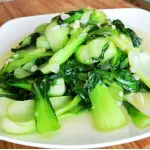
Stir fry Chinese vegetables with garlic
Stir-fry Chinese vegetables are so easy to prepare that we often take it for granted. Even though it may not qualify a place on the banquet menu, it remains as the most popular dish among Chinese households. Its popularity is because it can be completed within five minutes, with only a handful of ingredients.
Ingredients
- 300g of Chinese leafy vegetables of your choice
- 1 tsp salt
- 2 tbsp of chopped garlic
- 1/2 tsp sugar
- 2 tbsp cooking oil
Instructions
- Wash the vegetables.
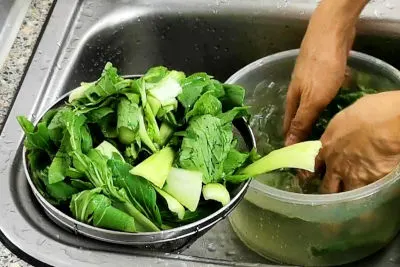
- Remove the stem, peel off the tough surface of the stem if necessary*. Cut the large stem diagonally (e.g., gai lan) into pieces.
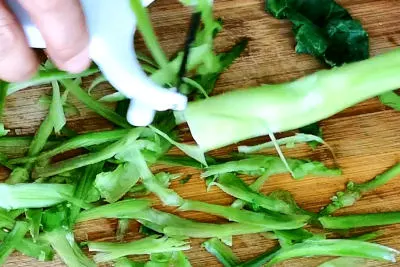
- Heat some oil in the wok. Saute the garlic over low heat.
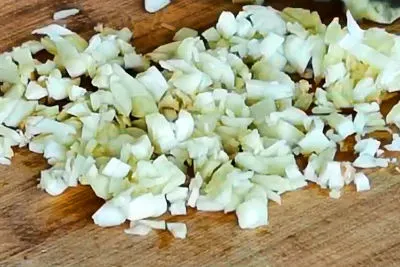
- When the garlic becomes fragrant, add the stem of the vegetables. Turn to high heat to stir-fry. Season with sugar and pepper.
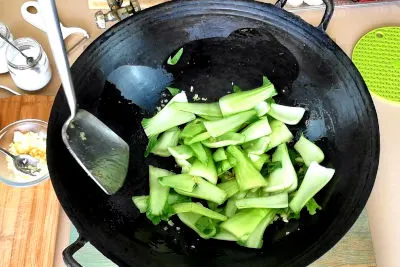
- Add 2 tbsps of water, cover and simmer for 2 minutes**. Remove the wok cover. Add the leaves. ***
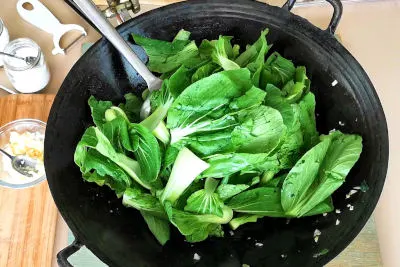
- Continue stir-frying over high heat until the leaves are wilted and the gravy is nearly dry out. Serve.
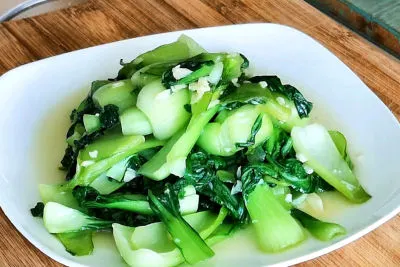
Notes
* Skip this step if the vegetables are tender and young. E.g., young gai lan 芥兰苗
**Actual timing depends on the size and toughness of the stem.
*** You can cook the leaves and stems together, and skip the simmering part if the vegetables are tender and young. E.g., small bok choy 小白菜.
Recommended Products
As an Amazon Associate and member of other affiliate programs, I earn from qualifying purchases.
Nutrition Information:
Yield: 2 Serving Size: 1Amount Per Serving: Calories: 238Total Fat: 14gSaturated Fat: 1gTrans Fat: 0gUnsaturated Fat: 13gCholesterol: 0mgSodium: 1217mgCarbohydrates: 23gFiber: 7gSugar: 6gProtein: 5g
This data was provided and calculated by Nutritionix on 4/19/2020


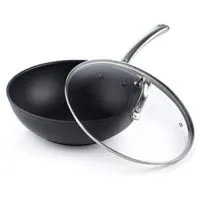


Marie Ramasamy
Thursday 23rd of April 2020
Thanks for the tips Kwan. I will remember to get my kai lan as dry as possible after washing AND add salt to garlic. Many thanks! Marie.
KP Kwan
Thursday 23rd of April 2020
Hi Marie, You are welcome. This method is what I am using and hope it works well for you too. KP Kwan
Chan Huey Ling
Wednesday 22nd of April 2020
Mr. Kwan, thank you so much !
KP Kwan
Thursday 23rd of April 2020
You are welcome, Chan :)
KP Kwan
Sunday 19th of April 2020
Hi, this is KP Kwan. I am happy to see you in this comment area, as you have read through my recipe. I am pleased to reply to any questions and comments as soon as possible.